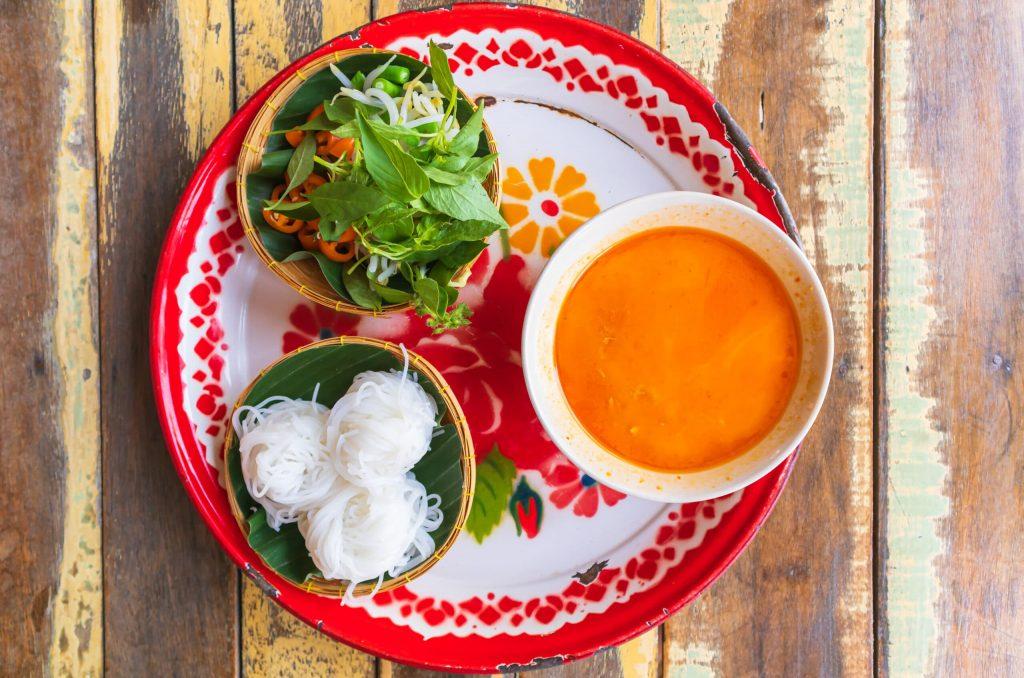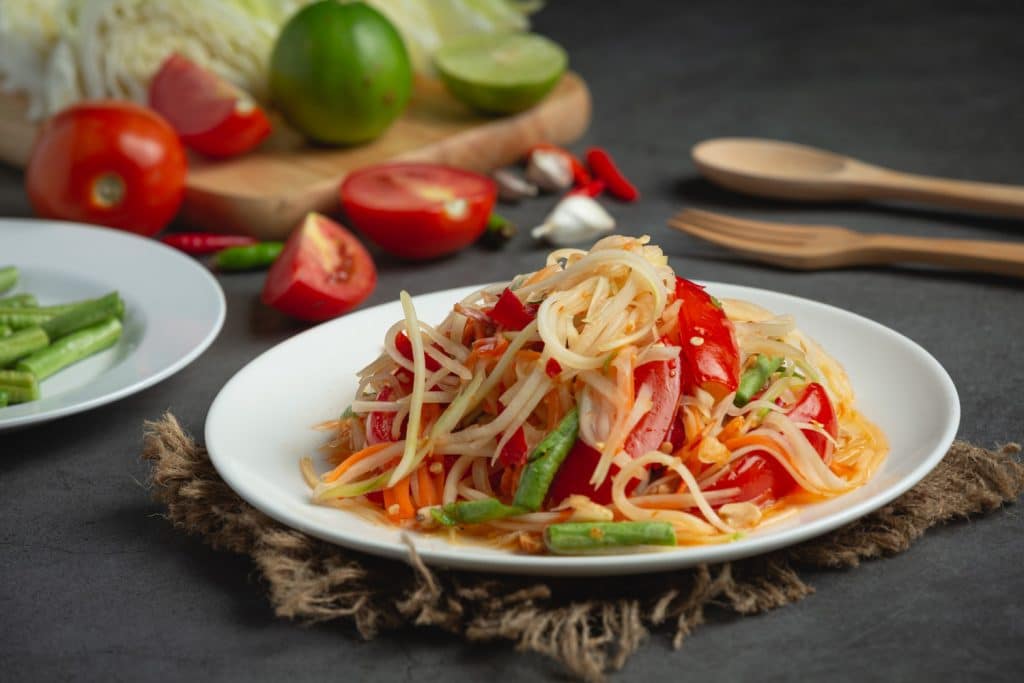Exploring the World of Vegetarian and Vegan Thai Cuisine
Exploring the World of Vegetarian and Vegan Thai Cuisine
Thai cuisine is renowned for its vibrant flavors, complex spice mixes, and fresh ingredients. However, it is often mistakenly perceived as being meat-centric. In reality, Thailand boasts a rich and diverse array of vegetarian and vegan dishes that have been a staple in Thai cuisine for centuries.
A Culinary Heritage
Vegetarianism and veganism have deep roots in Thai culture, heavily influenced by Theravada Buddhism, the predominant religion in Thailand. The Buddhist principle of “ahimsa,” or non-violence, extends to compassion for all living beings, including animals. This has led to a long tradition of plant-based cooking in Thailand, with monasteries often being the source of many vegetarian and vegan recipes.
Monks were some of the first vegetarians in Thailand, and their dietary preferences led to the development of a unique culinary tradition. Monastic cooking practices emphasized freshness, simplicity, and balance, and many of the vegetarian dishes that are popular today were originally created in monasteries.
Over time, vegetarian and vegan cuisine became more popular among the general population, and it is now an integral part of Thai culture. Today, there are many delicious and satisfying vegetarian and vegan options available at Thai restaurants and street food stalls throughout the country.
A Culinary Adventure
Thai vegetarian and vegan cuisine is not merely an absence of meat; it is a vibrant and delectable culinary world of its own. The use of fresh herbs, spices, and aromatics creates layers of flavor and depth that are both satisfying and nourishing.
Thai cuisine is known for its use of fresh herbs and spices, such as lemongrass, galangal, kaffir lime leaves, and chili peppers. These ingredients add complex flavors and aromas to Thai dishes, creating a unique and unforgettable culinary experience.
Vegetables play a central role in Thai vegetarian and vegan cuisine, not only as a source of nutrients but also as a key ingredient that adds flavor, texture, and visual appeal to the dishes. Thai cuisine is known for its abundance of fresh, seasonal vegetables, which are often stir-fried, steamed, or curried to enhance their natural flavors and create a symphony of textures.
Stir-Fried Vegetables
Stir-frying is a common cooking technique in Thai cuisine, particularly well-suited for preparing vegetables. Quick stir-frying over high heat helps retain crispness and vibrant colors while imparting a smoky flavor. Common stir-fried vegetables in Thai vegetarian and vegan cuisine include:
- Green beans: adding a slightly crunchy texture and a touch of sweetness to stir-fries.
- Eggplant: with its soft texture, absorbing Thai sauces and spices beautifully.
- Bell peppers: whether red, yellow, or green, adding burst of color, sweetness, and subtle crunch.
- Mushrooms: such as straw mushrooms, shiitake mushrooms, and oyster mushrooms, adding umami flavor and a meaty texture.
Steamed Vegetables
Steaming is another popular cooking method for vegetables in Thai cuisine, preserving delicate flavors and textures while maintaining nutritional value. Common steamed vegetables in Thai vegetarian and vegan cuisine include:
- Baby bok choy: small, leafy greens with a mild flavor and a slightly crunchy texture.
- Broccoli: adding a touch of sweetness and a slightly firm texture to steamed dishes.
- Carrots: providing sweetness and a slightly earthy flavor to steamed vegetables.
- Asparagus: adding a delicate flavor and a crisp texture to steamed dishes.
Curried Vegetables
Thai curries are known for rich flavors, complex spice blends, and creamy textures. Vegetables are often incorporated into Thai curries, adding unique flavors and textures. Common curried vegetables in Thai vegetarian and vegan cuisine include:
- Potatoes: adding a creamy texture and a mild flavor to curries.
- Zucchini: providing slightly sweet flavor and a soft texture to curries.
- Cauliflower: soaking up flavors of Thai curries and adding a slightly nutty flavor.
- Pumpkin: adding a touch of sweetness and a smooth texture to curries.

Rice Vermicelli with Red Curry
Vegetarian Red Curry: This rich and creamy red curry is typically made with chicken, but can be made vegetarian or vegan by using tofu or vegetables. It is typically flavored with chilies, coconut milk, and a variety of spices, often served with rice, rice vermicelli or roti.
The inclusion of a variety of vegetables in Thai vegetarian and vegan cuisine enhances flavor, texture, and provides a rich source of essential nutrients, vitamins, and minerals. Thai vegetarian and vegan dishes showcase the creativity and versatility of Thai cuisine, proving that plant-based ingredients can be transformed into culinary masterpieces.
Famous Dishes for Thais and Tourists
Here are some of the most famous vegetarian and vegan Thai dishes that are popular with both Thais and tourists:
- Pad Thai: This iconic Thai noodle dish is often made with shrimp or chicken, but can be made vegetarian or vegan by using tofu or tempeh. It is typically stir-fried with rice noodles, eggs, tamarind sauce, and a variety of vegetables.
- Tom Yum: This hot and sour soup is a classic Thai dish that can be made vegetarian or vegan by using mushrooms or tofu instead of seafood. It is typically flavored with lemongrass, galangal, kaffir lime leaves, and chili peppers, often served with rice noodles and a squeeze of lime.
- Khao Pad Sapparot: This stir-fried rice dish is packed with vegetables, tofu, and a flavorful tamarind sauce. It is a popular dish among Thais and tourists alike, often served with a side of pickled vegetables and chili peppers.
- Som Tam: This refreshing papaya salad is a staple in Thai cuisine and is typically made with green papaya, tomatoes, chili peppers, and fish sauce. However, the fish sauce can be omitted to make a vegan version, often served as a starter or side dish.
- Gaeng Phet: Vegetarian Green Curry: This rich and creamy green curry is typically made with chicken but can be made vegetarian or vegan by using tofu or vegetables. It is typically flavored with green chilies, coconut milk, and a variety of spices, often served with rice, rice vermicelli or roti.
Regional Variations in Vegetarian and Vegan Thai Cuisine
While Thai cuisine shares a common foundation of fresh ingredients, complex spice blends, and vibrant flavors, regional variations have emerged, influenced by local traditions, cultural practices, and available produce. Exploring these regional differences offers a deeper understanding of the nuances and diversity of vegetarian and vegan Thai cuisine.
Northern Thailand
In the mountainous regions of northern Thailand, vegetarian and vegan dishes typically reflect the influence of Lanna cuisine, characterized by a milder spice profile and the use of local ingredients like bamboo shoots, mushrooms, and wild herbs. Popular dishes include:
- Khantoke: A northern Thai set meal featuring an array of small plates, often including vegetarian options like steamed vegetables with nam prik, stir-fried vegetables with tofu, and vegetable curries.
- Sai Oua: A savory sausage typically made with pork, but can be made vegetarian using tofu or mushrooms, and flavored with lemongrass, galangal, and kaffir lime leaves.
Northeastern Thailand
Isan, the northeastern region of Thailand, is known for its spicy and flavorful cuisine, which often incorporates fermented ingredients like fish sauce and dried chili peppers. Vegetarian and vegan dishes in Isan showcase this bold flavor profile:
- Som Tam: Papaya salad, a staple in Thai cuisine, takes on a more intense flavor profile in Isan, with a generous amount of chili peppers and a sour, salty dressing.
- Tam Khae: A spicy and sour soup featuring eggplant, tomatoes, and a variety of mushrooms, often served with rice noodles or sticky rice.
Southern Thailand
Southern Thai cuisine is characterized by its use of coconut milk, turmeric, and fresh seafood. Vegetarian and vegan dishes in the south often incorporate these flavors, creating rich and flavorful dishes:
- Khao Soi: A noodle soup with a thick, coconut-based curry broth, often made with chicken or beef, but can be made vegetarian or vegan using tofu or vegetables.
- Gaeng Massaman: A popular curry dish with a rich and fragrant flavor profile, featuring potatoes, onions, and a variety of vegetables simmered in a coconut milk-based curry.
Thai Som Tum Papaya Salad
This refreshing papaya salad is a staple in Thai cuisine and is typically made with green papaya, tomatoes, chili peppers, and fish sauce. However, the fish sauce can be omitted to make a vegan version, often served as a starter or side dish. Alternatively, you can also use a vegan fish sauce for your dish.

Central Thailand
Central Thailand, where Bangkok is located, is home to a diverse range of vegetarian and vegan dishes, drawing influences from various regions and showcasing the culinary ingenuity of the city’s street food scene:
- Khao Pad Sapparot: A stir-fried rice dish with a sweet and sour tamarind sauce, often served with tofu, vegetables, and a side of pickled vegetables and chili peppers.
- Miang Kham: A small bite-sized appetizer featuring betel leaves, toasted coconut, dried shrimp, peanuts, and a variety of other ingredients, offering a balance of sweet, salty, and savory flavors.
These are just a few of the many delicious vegetarian and vegan Thai dishes that are available. With its diverse culinary traditions and fresh, flavorful ingredients, Thai vegetarian and vegan cuisine is a must-try for anyone seeking a delicious and rewarding culinary adventure.
